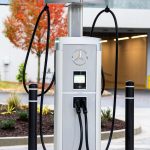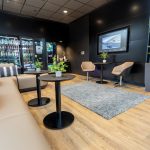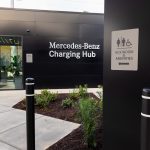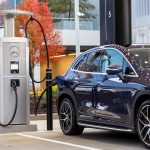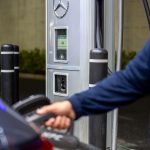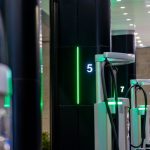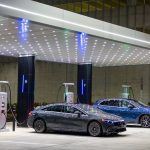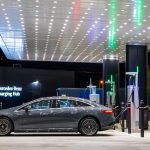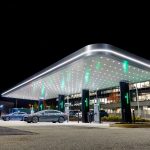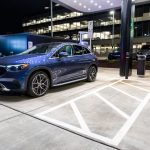
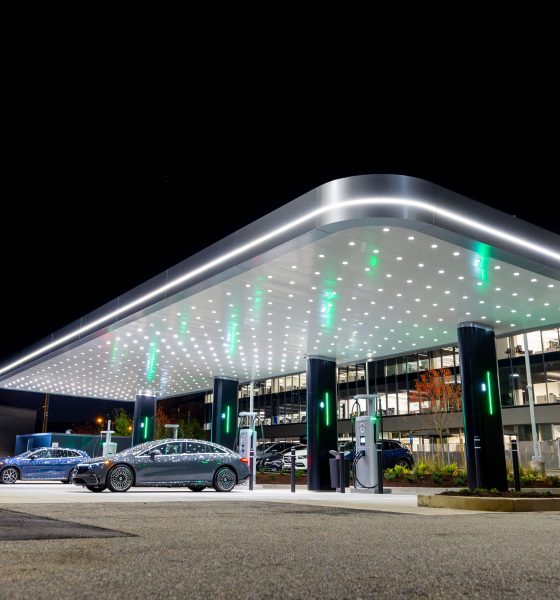
News
Mercedes-Benz launches first North American charging hub for all EV drivers
Mercedes-Benz announced today that it has officially launched the first North American charging hub at its Headquarters in Sandy Springs, Georgia.
The Mercedes-Benz Charging Hub is open to EV drivers of any manufacturer, offering a charging option for drivers outside of the German automaker’s models and expanding options for drivers of electric cars.
The charging hub is the first step in Mercedes-Benz’s commitment to invest over $1 billion in a joint venture with MN8 Energy. The two companies will collaborate to bring 2,500 chargers across at least 400 charging hubs in North America by the end of the 2020s.
“The Mercedes-Benz Charging Network expands global charging options for customers of all EV brands to promote clean, electric mobility,” Chairman of the Board of Management of Mercedes-Benz Mobility AG, Franz Reiner, said.
RELATED: Mercedes-Benz leans on ICE sales to bolster earnings as ‘brutal’ EV sector squeezes margins
“In North America, our strategy is clear: focusing on where EV drivers are and where they are going to enhance the North American EV charging map while setting new standards for quality and customer experience. These efforts will pave the way for greater EV adoption here in North America and around the world.”
The charging hub has several special features that will serve as a benchmark for future charging sites:
- 400kW Chargers: The first chargers installed are provided by ChargePoint and are all capable of charging rates of up to 400kW, offering customers some of the fastest charging speeds in the industry.
- Open to all from day one: Drivers of EVs from any brand can charge their vehicle and enjoy a Mercedes-Benz brand commensurate experience.
- Charging lounge: Charging hub customers can enjoy a premium, clean and comfortable environment while their vehicle charges, complete with couches and lounge chairs, vending machines, refreshments, and restroom facilities.
- Solar Canopy: Provides weather cover for customers, overhead LED lighting for safety and solar panels on top to generate passive clean electricity.
- Intelligent Indicators: A pylon built to a height of 15 feet, visible from the street, indicates the status of the charging stall: in use, free or reserved.
- Accessibility: The charging hub includes one charging spot, closest to the charging lounge, designed especially for handicap-accessible vehicles, as well as one uncovered, drive-through charging spot that is designed for electric vans or EVs with trailers up to 26 feet in length.
- Powered by clean energy: Through both direct and indirect means, the charging hub uses renewable energy and is carbon neutral.
At future locations, Mercedes-Benz said it will have “exclusive lounges” that will integrate a retail setting into a charging location. Charging will be the “backdrop” to grabbing a coffee with friends or recharging yourself while your car does the same.
- Credit: Mercedes-Benz
The partnership with MN8 Energy aims to help the charging hub remain up and running to give those who visit a reliable place to charge their cars. So many EV charging companies have had issues with keeping their chargers maintained, and all too frequently, we see reports of people visiting stalls to charge their cars, but being presented with malfunctioning charging piles.
This is the first of many Mercedes-Benz charging hubs, as we can expect at least sixty of these to come to fruition every year until 2030.
I’d love to hear from you! If you have any comments, concerns, or questions, please email me at joey@teslarati.com. You can also reach me on Twitter @KlenderJoey, or if you have news tips, you can email us at tips@teslarati.com.

Elon Musk
SpaceX Starship Version 3 booster crumples in early testing
Photos of the incident’s aftermath suggest that Booster 18 will likely be retired.

SpaceX’s new Starship first-stage booster, Booster 18, suffered major damage early Friday during its first round of testing in Starbase, Texas, just one day after rolling out of the factory.
Based on videos of the incident, the lower section of the rocket booster appeared to crumple during a pressurization test. Photos of the incident’s aftermath suggest that Booster 18 will likely be retired.
Booster test failure
SpaceX began structural and propellant-system verification tests on Booster 18 Thursday night at the Massey’s Test Site, only a few miles from Starbase’s production facilities, as noted in an Ars Technica report. At 4:04 a.m. CT on Friday, a livestream from LabPadre Space captured the booster’s lower half experiencing a sudden destructive event around its liquid oxygen tank section. Post-incident images, shared on X by @StarshipGazer, showed notable deformation in the booster’s lower structure.
Neither SpaceX nor Elon Musk had commented as of Friday morning, but the vehicle’s condition suggests it is likely a complete loss. This is quite unfortunate, as Booster 18 is already part of the Starship V3 program, which includes design fixes and upgrades intended to improve reliability. While SpaceX maintains a rather rapid Starship production line in Starbase, Booster 18 was generally expected to validate the improvements implemented in the V3 program.
Tight deadlines
SpaceX needs Starship boosters and upper stages to begin demonstrating rapid reuse, tower catches, and early operational Starlink missions over the next two years. More critically, NASA’s Artemis program depends on an on-orbit refueling test in the second half of 2026, a requirement for the vehicle’s expected crewed lunar landing around 2028.
While SpaceX is known for diagnosing failures quickly and returning to testing at unmatched speed, losing the newest-generation booster at the very start of its campaign highlights the immense challenge involved in scaling Starship into a reliable, high-cadence launch system. SpaceX, however, is known for getting things done quickly, so it would not be a surprise if the company manages to figure out what happened to Booster 18 in the near future.
News
Tesla FSD (Supervised) is about to go on “widespread” release
In a comment last October, Elon Musk stated that FSD V14.2 is “for widespread use.”

Tesla has begun rolling out Full Self-Driving (Supervised) V14.2, and with this, the wide release of the system could very well begin.
The update introduces a new high-resolution vision encoder, expanded emergency-vehicle handling, smarter routing, new parking options, and more refined driving behavior, among other improvements.
FSD V14.2 improvements
FSD (Supervised) V14.2’s release notes highlight a fully upgraded neural-network vision encoder capable of reading higher-resolution features, giving the system improved awareness of emergency vehicles, road obstacles, and even human gestures. Tesla also expanded its emergency-vehicle protocols, adding controlled pull-overs and yielding behavior for police cars, fire trucks, and ambulances, among others.
A deeper integration of navigation and routing into the vision network now allows the system to respond to blocked roads or detours in real time. The update also enhances decision-making in several complex scenarios, including unprotected turns, lane changes, vehicle cut-ins, and interactions with school buses. All in all, these improvements should help FSD (Supervised) V14.2 perform in a very smooth and comfortable manner.
Elon Musk’s predicted wide release
The significance of V14.2 grows when paired with Elon Musk’s comments from October. While responding to FSD tester AI DRIVR, who praised V14.1.2 for fixing “95% of indecisive lane changes and braking” and who noted that it was time for FSD to go on wide release, Musk stated that “14.2 for widespread use.”
FSD V14 has so far received a substantial amount of positive reviews from Tesla owners, many of whom have stated that the system now drives better than some human drivers as it is confident, cautious, and considerate at the same time. With V14.2 now rolling out, it remains to be seen if the update also makes it to the company’s wide FSD fleet, which is still populated by a large number of HW3 vehicles.
News
Tesla FSD V14.2 starts rolling out to initial batch of vehicles
It would likely only be a matter of time before FSD V14.2 videos are posted and shared on social media.
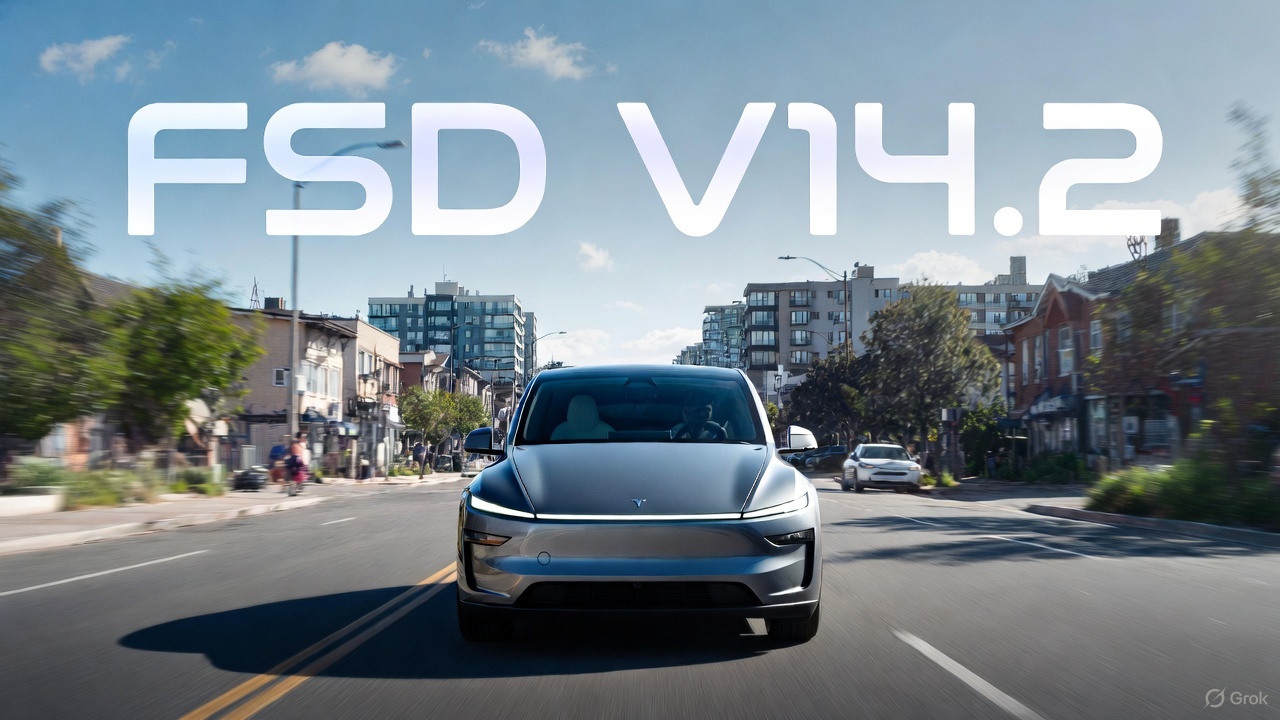
Tesla has begun pushing Full Self-Driving (Supervised) v14.2 to its initial batch of vehicles. The update was initially observed by Tesla owners and veteran FSD users on social media platform X on Friday.
So far, reports of the update have been shared by Model Y owners in California whose vehicles are equipped with the company’s AI4 hardware, though it would not be surprising if more Tesla owners across the country receive the update as well.
Based on the release notes of the update, key improvements in FSD V14.2 include a revamped neural network for better detection of emergency vehicles, obstacles, and human gestures, as well as options to select arrival spots.
It would likely only be a matter of time before FSD V14.2 videos are posted and shared on social media.
Following are the release notes of FSD (Supervised) V14.2, as shared on X by longtime FSD tester Whole Mars Catalog.

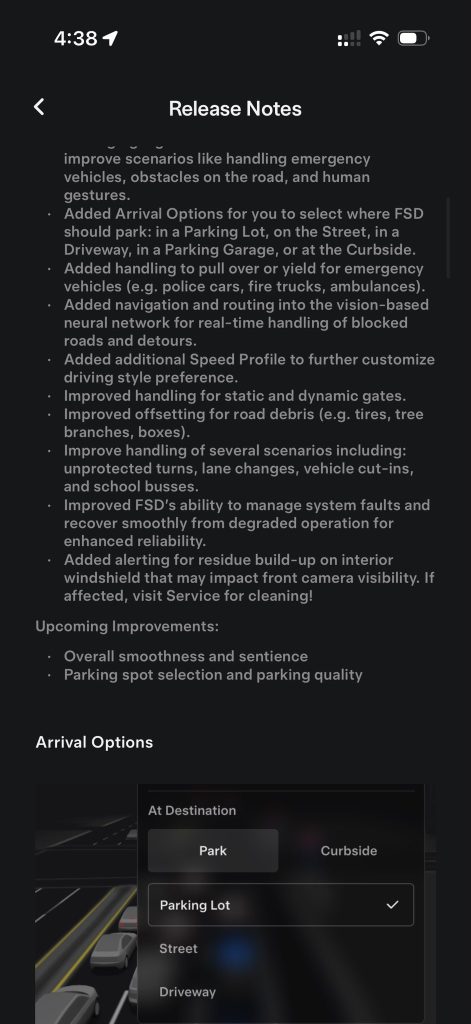
Release Notes
2025.38.9.5
Currently Installed
FSD (Supervised) v14.2
Full Self-Driving (Supervised) v14.2 includes:
- Upgraded the neural network vision encoder, leveraging higher resolution features to further improve scenarios like handling emergency vehicles, obstacles on the road, and human gestures.
- Added Arrival Options for you to select where FSD should park: in a Parking Lot, on the Street, in a Driveway, in a Parking Garage, or at the Curbside.
- Added handling to pull over or yield for emergency vehicles (e.g. police cars, fire trucks, ambulances.
- Added navigation and routing into the vision-based neural network for real-time handling of blocked roads and detours.
- Added additional Speed Profile to further customize driving style preference.
- Improved handling for static and dynamic gates.
- Improved offsetting for road debris (e.g. tires, tree branches, boxes).
- Improve handling of several scenarios including: unprotected turns, lane changes, vehicle cut-ins, and school busses.
- Improved FSD’s ability to manage system faults and improve scenarios like handling emergency vehicles, obstacles on the road, and human gestures.
- Added Arrival Options for you to select where FSD should park: in a Parking Lot, on the Street, in a Driveway, in a Parking Garage, or at the Curbside.
- Added handling to pull over or yield for emergency vehicles (e.g. police cars, fire trucks, ambulances).
- Added navigation and routing into the vision-based neural network for real-time handling of blocked roads and detours.
- Added additional Speed Profile to further customize driving style preference.
- Improved handling for static and dynamic gates.
- Improved offsetting for road debris (e.g. tires, tree branches, boxes).
- Improve handling of several scenarios, including unprotected turns, lane changes, vehicle cut-ins, and school buses.
- Improved FSD’s ability to manage system faults and recover smoothly from degraded operation for enhanced reliability.
- Added alerting for residue build-up on interior windshield that may impact front camera visibility. If affected, visit Service for cleaning!
Upcoming Improvements:
- Overall smoothness and sentience
- Parking spot selection and parking quality
